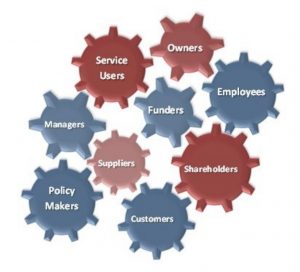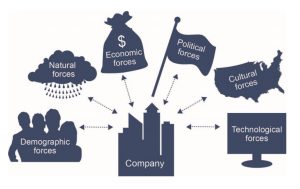Foundations of Business
1 Chapter 1: Foundations of Business
Learning Objectives
- Describe the concept of stakeholders and identify the stakeholder groups relevant to an organization
- Discuss and be able to apply the macro-business environment model to an industry or emerging technology
- Explain other key terms related to this chapter including: entrepreneur; profit; revenue
Introduction
Today is an interesting time to study business. Advances in technology are bringing rapid changes in the ways we produce and deliver goods and services. The Internet and other improvements in communication (such as smartphones, video conferencing, and social networking) now affect the way we do business. Companies are expanding international operations, and the workforce is more diverse than ever. Corporations are being held responsible for the behavior of their executives, and more people share the opinion that companies should be good corporate citizens. Because of the role they played in the worst financial crisis since the Great Depression, businesses today face increasing scrutiny and negative public sentiment.[1]
Economic turmoil that began in the housing and mortgage industries as a result of troubled subprime mortgages quickly spread to the rest of the economy. In 2008, credit markets froze up and banks stopped making loans. Lawmakers tried to get money flowing again by passing a $700 billion Wall Street bailout, now-cautious banks became reluctant to extend credit. Without money or credit, consumer confidence in the economy dropped and consumers cut back on spending. Unemployment rose as troubled companies shed the most jobs in five years, and 760,000 Americans marched to the unemployment lines.[2] The stock market reacted to the financial crisis and its stock prices dropped by 44% while millions of Americans watched in shock as their savings and retirement accounts took a nose dive. In fall 2008, even Apple, a company that had enjoyed strong sales growth over the past five years, began to cut production of its popular iPhone. Without jobs or cash, consumers would no longer flock to Apple’s fancy retail stores or buy a prized iPhone.[3] Since then, things have turned around for Apple, which continues to report blockbuster sales and profits. But not all companies or individuals are doing so well. The economy is still struggling, unemployment is high (particularly for those ages 16 to 24), and home prices have not fully rebounded from the crisis.
As you go through the course with the aid of this text, you’ll explore the exciting world of business. We’ll introduce you to the various activities in which business people engage— accounting, finance, information technology, management, marketing, and operations. We’ll help you understand the roles that these activities play in an organization, and we’ll show you how they work together. We hope that by exposing you to the things that business people do, we’ll help you decide whether a business is right for you and, if so, what areas of business you’d like to study further.
Getting Down to Business
A business is any activity that provides goods or services to consumers for the purpose of making a profit. Be careful not to confuse the terms revenue and profit. Revenue represents the funds an enterprise receives in exchange for its goods or services. Profit is what’s left (hopefully) after all the bills are paid. When Steve Jobs and Steve Wozniak launched the Apple I, they created Apple Computer in Jobs’ family garage in the hope of making a profit. Before we go on, let’s make a couple of important distinctions concerning the terms in our definitions.
First, whereas Apple produces and sells goods(Mac, iPhone, iPod, iPad, Apple Watch), many businesses provide services. Your bank is a service company, as is your Internet provider. Hotels, airlines, law firms, movie theaters, and hospitals are also service companies. Many companies provide both goods and services. For example, your local car dealership sells goods (cars) and also provides services (automobile repairs).
Second, some organizations are not set up to make profits. Many are established to provide social or educational services. Such not-for profit (or nonprofit), organizations include the United Way of America, Habitat for Humanity, the Boys and Girls Clubs, the Sierra Club, the American Red Cross, and many colleges and universities. Most of these organizations, however, function in much the same way as a business. They establish goals and work to meet them in an effective, efficient manner. Thus, most of the business principles introduced in this text also apply to nonprofits.
Business Participants and Activities
Let’s begin our discussion of business by identifying the main participants of business and the functions that most businesses perform. Then we’ll finish this section by discussing the external factors that influence a business’ activities.
Participants
Every business must have one or more owners whose primary role is to invest money in the business. When a business is being started, it’s generally the owners who polish the business idea and bring together the resources (money and people) needed to turn the idea into a business. The owners also hire employees to work for the company and help it reach its goals. Owners and employees depend on a third group of participants— customers. Ultimately, the goal of any business is to satisfy the needs of its customers in order to generate a profit for the owners.
Stakeholders
Consider your favorite restaurant. It may be an outlet or franchise of a national chain (more on franchises in a later chapter) or a local “mom and pop” without affiliation to a larger entity. Whether national or local, every business has stakeholders– those with a legitimate interest in the success or failure of the business and the policies it adopts. Stakeholders include customers, vendors, employees, landlords, bankers, and others (see Figure 1.2). All have a keen interest in how the business operates, in most cases for obvious reasons. If the business fails, employees will need new jobs, vendors will need new customers, and banks may have to write off loans they made to the business. Stakeholders do not always see things the same way – their interests sometimes conflict with each other. For example, lenders are more likely to appreciate high profit margins that ensure the loans they made will be repaid, while customers would probably appreciate the lowest possible prices. Pleasing stakeholders can be a real balancing act for any company.

Functional Areas of Business
The activities needed to operate a business can be divided into a number of functional areas. Examples include: management, operations, marketing, accounting, and finance. Let’s briefly explore each of these areas.
Management
Managers are responsible for the work performance of other people. Management involves planning for, organizing, leading, and controlling a company’s resources so that it can achieve its goals. Managers plan by setting goals and developing strategies for achieving them. They organize activities and resources to ensure that company goals are met and staff the organization with qualified employees and managers lead them to accomplish organizational goals. Finally, managers design controls for assessing the success of plans and decisions and take corrective action when needed.
Operations
All companies must convert resources (labor, materials, money, information, and so forth) into goods or services. Some companies, such as Apple, convert resources into tangible products—Macs, iPhones, etc. Others, such as hospitals, convert resources into intangible products — e.g., health care. The person who designs and oversees the transformation of resources into goods or services is called an operations manager. This individual is also responsible for ensuring that products are of high quality.
Marketing
Marketing consists of everything that a company does to identify customers’ needs (i.e. market research) and design products to meet those needs. Marketers develop the benefits and features of products, including price and quality. They also decide on the best method of delivering products and the best means of promoting them to attract and keep customers. They manage relationships with customers and make them aware of the organization’s desire and ability to satisfy their needs.
Accounting
Managers need accurate, relevant and timely financial information, which is provided by accountants. Accountants measure, summarize, and communicate financial and managerial information and advise other managers on financial matters. There are two fields of accounting. Financial accountants prepare financial statements to help users, both inside and outside the organization, assess the financial strength of the company. Managerial accountants prepare information, such as reports on the cost of materials used in the production process, for internal use only.
Finance
Finance involves planning for, obtaining, and managing a company’s funds. Financial managers address such questions as the following: How much money does the company need? How and where will it get the necessary money? How and when will it pay the money back? What investments should be made in plant and equipment? How much should be spent on research and development? Good financial management is particularly important when a company is first formed, because new business owners usually need to borrow money to get started.
External Forces that Influence Business Activities
Apple and other businesses don’t operate in a vacuum: they’re influenced by a number of external factors. These include the economy, government, consumer trends, technological developments, public pressure to act as good corporate citizens, and other factors. Collectively, these forces constitute what is known as the “macro environment” – essentially the big picture world outside over which the business exerts very little if any control. Figure 1.3 “Business and Its Environment” sums up the relationship between a business and the external forces that influence its activities. One industry that’s clearly affected by all these factors is the fast-food industry. Companies such as Taco Bell, McDonald’s, Cook-Out and others all compete in this industry. A strong economy means people have more money to eat out. Food standards are monitored by a government agency, the Food and Drug Administration. Preferences for certain types of foods are influenced by consumer trends (fast food companies are being pressured to make their menus healthier). Finally, a number of decisions made by the industry result from its desire to be a good corporate citizen. For example, several fast-food chains have responded to environmental concerns by eliminating Styrofoam containers.[4]
Of course, all industries are impacted by external factors, not just the food industry. As people have become more conscious of the environment, they have begun to choose new technologies, like all-electric cars to replace those that burn fossil fuels. Both established companies, like Nissan with its Nissan Leaf, and brand new companies like Tesla have entered the market for all-electric vehicles. While the market is still small, it is expected to grow at a compound annual growth rate of 19.2% between 2013 and 2019.[5]

Key Takeaways
- The main participants in a business are its owners, employees, and customers.
- Every business must consider its stakeholders, and their sometimes conflicting interests, when making decisions.
- The activities needed to run a business can be divided into functional areas. The business functions correspond fairly closely to many majors found within a typical college of business.
- Businesses are influenced by such external factors as the economy, government, and other forces external to the business.
What Makes Shopify Successful? [6]

- The system is scalable: An infinitely scalable SaaS platform. Even if you don’t totally understand what that means, you can rest easy knowing it means your site will never crash. A fast and easy experience awaits every customer, any time.
- The system is secure: Customers need to feel that their personal information, including credit cards, is safe when they shop online. Shopify is certified Level 1 PCI DSS compliant, meaning Shopify has been deemed compliant in six different categories set out by the Payment Card Industry Data Security Standard.
- An API makes integrations fast and easy: Shopify is built for seamless integrations, which makes everyone happier. Their API lets you connect to your existing IT platform and the ERP, web app, CRM, accounting systems, a preferred CMS and other third party software.
- Healthy 3rd Party developer community lowers cost of adding plugins for specific features: For the last six years Shopify Plus has been augmented by pre-approved apps that add features or customize things on the backend. The ecosystem that produces these add-ons and plugins is is regulated and overseen by Shopify, which helps ensure quality. For even the most complex logistics, there’s likely an affordable solution already available.
- Marketing Automation Capabilities: Shopify Plus offers built-in automation features such as Abandoned Checkout Recovery in the Professional or Unlimited plan. There are several apps available for the basic plan to add this feature.
- Advanced Reporting for SEO: Shopify knows shoppers need to find you. Their advanced eCommerce CMS and shopping cart feature customizable H1, title and meta tags for SEO best practice, helping bring in traffic and getting you noticed by Google, Bing and Yahoo. Plus, new products and site changes show up fast on search engines through automatic sitemaps.xml file generation.
- 24/7 support: eCommerce means your store is open all the time. Shopify gets it and offers a support team available all day, every day. No filling out an online form and waiting for a reply for days. Email, live chat and phone are all available. When you’re in business, so is Shopify.
- eCommerce University education series great for beginners and the experienced alike: Shopify wants your business to thrive and offers a huge range of free tools and resources to build your store and your success. Free guides, a forum, online marketing advice, and in-depth case studies help you build, launch and grow your own online business.
- Easy to use: All those options and features are great. But Shopify Plus is better than great because it’s easy to use. User friendly to the max, Shopify has set itself apart as the ecommerce option focused on ease of use, allowing companies to focus on customer experience and marketing instead of building out, maintaining and working in expensive systems.
- Shopify Plus API: For the enterprise customers that have Magento, SAP, SAGE, NetSuite or other ERP solutions. The ability to easily port over existing customers, make integrations easily at low cost, and transact at lower cost is very appealing. Shopify Plus is really helping enterprise take advantage of many tools thought to be for small business. Shopify Plus vs Magento Enterprise, we would pick Shopify Plus any day.
- Jon Hilsenrath, Serena Ng, and Damian Paletta (2008). “Worst Crisis Since ’30s, With No End Yet in Sight,” Wall Street Journal, Markets, September 18, 2008. Retrieved from: http://www.wsj.com/articles/SB122169431617549947 ↵
- Steve Hargreaves (2008). “How the Economy Stole the Election,” CNN.com. Retrieved from: http://money.cnn.com/galleries/2008/news/0810/gallery.economy_election/index.html ↵
- Dan Gallagher (2008). “Analyst says Apple is cutting back production as economy weakens.” MarketWatch. Retrieved from: http://www.marketwatch.com/story/apple-cutting-back-iphoneproduction-analyst-says?amp%3Bdist=msr_1 ↵
- David Baron (2003). “Facing-Off in Public.” Stanford Business. August 2003, pp. 20-24. Retrieved from: https://www.gsb.stanford.edu/sites/gsb/files/2003August.pdf ↵
- Transparency Market Research (2014). “Electric Vehicles Market (on-road) (hybrid, plug-in, and battery) - Global Industry Analysis, Size, Share, Growth, Trends and Forecast, 2013 – 2019.” Retrieved from: http://www.transparencymarketresearch.com/electric-vehicles-market.html ↵
- Source: Parmar (2016). https://www.quora.com/What-makes-Shopify-successful. ↵
funds an enterprise receives in exchange for its goods or services
those with a legitimate interest in the success or failure of the business and the policies it adopts.
the application of planning, organizing, staffing, directing, and controlling functions in the most efficient manner possible to accomplish meaningful organizational objectives.
consists of everything that a company does to identify customers’ needs (i.e. market research) and design products to meet those needs.

